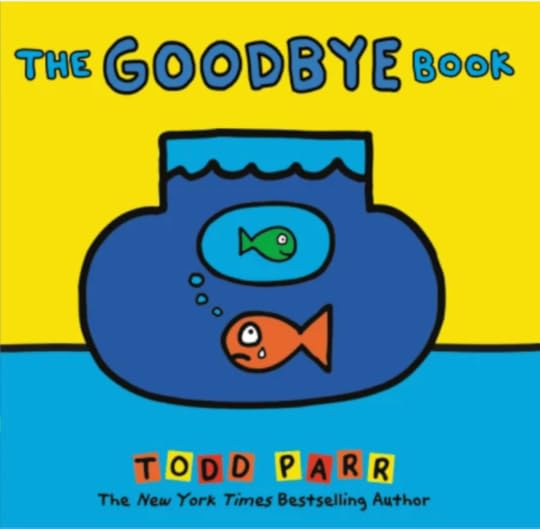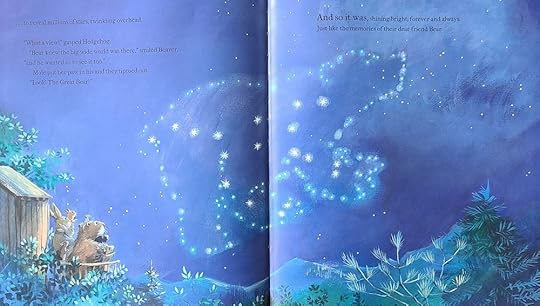Helping kids grieve with ‘Goodbye Bear’
 Goodbye Bear by Jane Chapman (Little Tiger Press, 2022)Good to Read for:the calm, comforting storychildren who are grievingexplaining loss and bereavementI frequently praise picture books for their role in developing children’s empathy. Simply put, they enable kids to step into the shoes of another, equipping them to see the world and experience feelings from someone else’s perspective.
Goodbye Bear by Jane Chapman (Little Tiger Press, 2022)Good to Read for:the calm, comforting storychildren who are grievingexplaining loss and bereavementI frequently praise picture books for their role in developing children’s empathy. Simply put, they enable kids to step into the shoes of another, equipping them to see the world and experience feelings from someone else’s perspective. But picture books have another critical function in your child’s development – by helping them understand (and own) their own feelings.
Sometimes, these may be too complicated to articulate. For example, children experiencing grief and loss following the death of a beloved pet or grandparent.
We may shy away from the subject of death (particularly by those of us in the West). But as last week’s funeral of Her Majesty Queen Elizabeth II reminded us – one day, even the greatest among us shall die. It’s a sobering thought – but an inescapable fact.
“From movies like The Lion King to real-world events, children may be confronted with death even before they have to deal with it on a personal level,” notes Dena McMurdie for Brightly. “It’s always a good idea to address the topic of death with your children before their first experience with it.”
[ 7 Beautiful Picture Books to Help Kids Understand Death ]Death is not the only reason for children to experience loss and grief. Such feelings may result from various situations, including:
Moving home (or a friend moving away).
A family break-up.
Even a precious toy that becomes lost.
‘Expressing grief is healthy, and attempts to avoid these feelings can cause problems in the future,’ notes Child Bereavement UK in How We Grieve.
So how on Earth do we address this sensitive area with young children? The good news is that picture books are there to help!
A charming and compelling example is the boldly illustrated, The Goodbye Book by Todd Parr, in which the narrator (a goldfish) addresses the reader directly. It’s open to interpretation – so it easily applies to any situation that causes feelings of loss and sadness. In this sense, it sits well with The Snowman by Raymond Briggs (although it couldn’t be further removed visually).


Another famous example of a picture book about grief (following the death of its protagonist) is Badger’s Parting Gifts by Susan Varley. It and The Snowman have been around for decades – a testament to their quality and enduring appeal. Over the years, Badger’s Parting Gifts, in particular, has helped countless grieving families to open up and share their feelings. (The 35th anniversary edition even includes a guide from Child Bereavement UK, with suggestions on how to use the book and help children understand grief.)
Now a newly published picture book is set to follow in their wake (no pun intended): Goodbye Bear by Jane Chapman.
Goodbye Bear by Jane Chapman (Little Tiger Press, 2022) is a moving story about grief and loss that kids will find comforting.From the start, it gently tackles the sensitive subject of death head-on right with the opening lines:
Bear died on a Friday, while sunlight speckled the grass…
and caterpillars nibbled on leaves in the forest.
It’s notable that Bear isn’t depicted in the illustration - neither here nor anywhere else in the book. (This makes Goodbye Bear unique among my personal recommendations of picture books about grief and loss.) Instead, Chapman allows Bear’s grieving friends to paint a vivid picture of him as they reminisce. Combined with incidental details that depict a few of Bear’s belongings – a sun hat and tools, for example – his character shines through.
Goodbye Bear is as much about the grieving friends who are left behind. The focus is on two in particular – Beaver and Mole ‘who found it hard to understand that Bear was gone.’ And as with anyone experiencing a bereavement, they feel a whole array of emotions:
Confusion: “I keep hearing his voice…and run outside but there’s no one there.”
Sadness: Sometimes they cried.
Regret: “I have so many things I want to tell him,” said Mole.
Anger: “Sometimes I feel very cross because Bear dies. How could he leave us?” And Beaver screwed up his paper crown and threw it on the fire.
Sometimes, the friends feel numb and ‘just [sit] in silence.’
Time passes, and the seasons change. Gradually, Beaver and Mole realise that Bear wouldn’t want them to be sad. Come spring, they decide to revisit Bear’s treehouse. “The woods will be full of snowdrops. Bear loved snowdrops.”

Chapman’s text is gentle, and the dialogue feels authentic. I love the moment when the two friends reach the treehouse:
“Do you think Bear would mind if we went in?” whispered Beaver.
Mole thought about Bear’s kindly face.
“Bear loved us,” she said, “and he wouldn’t mind in the slightest.”
“Quite right,” agreed Beaver, offering Mole a paw.

Once inside, they become quite animated as they are reminded of Bear. So they decide to finish his treehouse and enlist the help of their friends.
Hammering and sawing rang through the forest.
“I thought I heard Bear again!” chuckled Rabbit, hopping up.
“What a racket!”
As they build, they chat about Bear, reflecting honestly about the departed. Their reminiscences help ease their sadness and add gentle humour to the proceedings.
“I remember when he rescued you from the pond!” giggled Mouse.
“And how his endless whistling got on my nerves!” shouted Rabbit.
Building the treehouse allows Bear’s friends the opportunity to grieve while honouring his memory. In doing so, they learn to cope with the loss and discover something precious - Hope and Joy. It’s not expressly written – but it emanates from the characters’ expressions and body language. They are moving through the grieving process – looking forward to the future while remembering the past.
Child Bereavement UK points out that ‘grieving is not about forgetting the person who has died but about finding ways to remember them.’ They suggest creating something in memory of the deceased (for example, a painting or poem) or making a memory box to put trinkets and reminders in.
Bear’s friends effectively tick both boxes by completing his treehouse. While doing so, they find it already contains things that remind them of him – a little stool intended for Mole and Bear’s painting of the Great Bear constellation, which they hang on the wall.

Once the treehouse is finished, Bear’s friends share cake and stories.
Then, when it was dark, Beaver lit the lanterns so that no one would be scared.
Just like Bear used to do.
And when they open the shutters onto the night sky, they discover something else to shine light onto Bear’s memory: The Great Bear constellation: ‘shining bright, forever and always. Just like the memories of their dear friend Bear.’
Chapman hopes Goodbye Bear “will be a useful book for parents and carers to encourage young children to process their own experiences of loss.” For that reason, joyful picture books like this are welcomed. Because they’re about more than death. They are a celebration of life and a testament to the power of community and friendship – particularly in times of sadness.
 Tips for sharing Goodbye Bear
Tips for sharing Goodbye BearThe story tackles mortality with gentle humour and compassion. This makes it ideal for sharing with young children even before they experience death firsthand.
Children may experience loss and grief for various reasons, including moving away from friends or family break-ups. Goodbye Bear helps you open up conversation and the child deal with Big Emotions. ‘Expressing grief is healthy, and attempts to avoid these feelings can cause problems in the future.’ [Child Bereavement UK]
Read it with a child who has lost a loved one. Reminisce and share happy memories. Perhaps ask, “Which character where they most like?”
STORIES WORTH SHARINGGoodbye Bear by Jane Chapman (Little Tiger Press, 2022)Good to Read for:the calm, gentle storychildren who are grievingexplaining loss and bereavementCopyright © 2022 Jane Chapman (Text & Illustrations)From GOODBYE BEAR by Jane Chapman(Little Tiger Press)Illustration from The Goodbye Book © 2016 by Todd ParrIllustration from Badger’s Parting Gifts © 1984 by Susan VarleyGOOD TO READBest picture books about grief and lossThe Snowman by Raymond Briggs
Granpa by John Burningham
Goodbye Bear by Jane Chapman
Grandad’s Island by Benji Davies
The Heart and the Bottle by Oliver Jeffers
The Goodbye Book by Todd Parr
Famous Fred by Posy Simmonds
Badger’s Parting Gifts by Susan Varley
The Tide by Clare Helen Welsh & Ashling Lindsay
Find further recommendations at Booktrust.
BUY THE BOOKPowered by Bookshop.org
Supporting independent bookshops

“[A] wonderful story to read together as a family.”– Red Reading Hub“Perfect for young children dealing with big emotions.”– Books Up North Buy UK Buy USA * I EARN COMMISSION FROM THESE LINKS #AD/AFFRELATED ARTICLESSOURCES 7 Beautiful Picture Books to Help Kids Understand Death (Dena McMurdie, readbrightly.com)How we grieve (childbereavementuk.org) Remembering someone who has died (childbereavementuk.org) Goodbye Bear (Jill Bennett, 25 March 2022)Kid’s Book Review: Goodbye Bear (Sarah Tyson, booksupnorth.com, 14 March 2022) Goodbye Bear (janekchapman.com)Are you stuck for quality stories that you and your kids will enjoy? Sign up for your free weekly email with story recommendations and tips. Sign up here © 2022 BY TIM WARNES(UNLESS OTHERWISE ATTRIBUTED)****USE OF THIRD-PARTY COPYRIGHTED MATERIAL FALLS UNDER FAIR USE/FAIR DEALING PRACTICE
My Life in Books
For lovers of kid lit, this memoir - My Life in Books - is intended to give you the confidence and encouragement to share your own passion; to help you make lasting connections through kids’ books.
Originally posted at www.timwarnes.com ...more
- Tim Warnes's profile
- 30 followers



